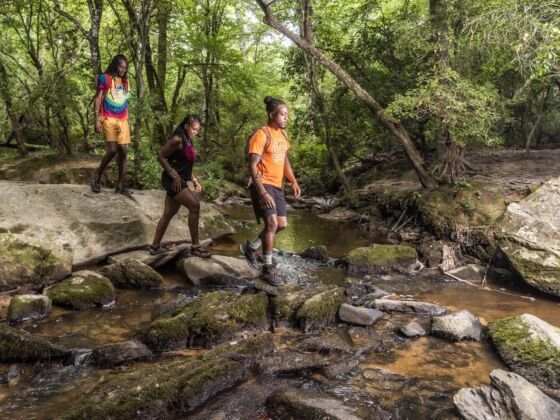North Carolina trails: Welcoming everyone into the outdoors
In North Carolina, you can find the “great” in the great outdoors any day, any season, any moment, anywhere. There are trails, treks, paddles, and paths for wandering in the mountains, rolling through the Piedmont, or winding along the coast, no matter your ability. Wherever and whoever you are, there’s a trail that’ll rise to meet you, delivering you to a destination you won’t soon forget.
The state’s trove of diverse landscapes — 300+ miles of shoreline rising to the highest peaks in the American East — seem purpose-built to welcome everyone. Just remember to visit responsibly. When you explore the spots below, be it with boots, wheels, or paddles, be prepared to take some great pictures, make some great memories, and to leave North Carolina’s outdoors just as great you found them.

There’s more to the coast than beaches and dunes (though you could have an excellent trip sticking to those features alone, of course). When you delve deeper into North Carolina’s coastal region, you’ll find a whole other world on this watery plain — one where rivers, marshes, lakes, and forests provide refuge for wildlife, along with a much-needed chance to unplug for us.
At Pettigrew State Park, you can explore by land or water. Paths and bike trails wander through old-growth forests at the north end of Lake Phelps, 16,000 acres of water you can take to by kayak or canoe. You’re also welcome to camp on the shores of this mysterious lake — no one knows how it formed or how long it’s been here, but 4,000-year-old dugout canoes used by Indigenous peoples have been found beneath the crystalline waters. This is a pretty storied place, so practice Outdoor NC Leave No Trace principles to help keep the park in prime condition for the next visitor. Keep your campsite confined to designated areas, and be sure to travel only on marked trails; sensitive ecosystems rely on us for protection.
Nearby, the Alligator River National Wildlife Refuge offers more than 152,000 acres of quiet woods, swamps, and waterways. Get out and paddle the blackwater creeks via 15+ miles of marked and color-coded paddle trails (the water’s been stained tea-black from organic matter in the soil, hence the name), or keep your adventure on the tame side by driving the Wildlife Trail. You might spot a few bears, some white-tailed deer, and many different bird species on your journey. Don’t leave before checking out the Creef Cut and Sandy Ridge areas, where short trails lead to especially wildlife-rich areas. Here too you can practice Outdoor NC Leave No Trace principles and let the wildlife stay wild by observing from a distance and taking only photos.
More boating awaits on the Neuse River Paddle Trail, stretching 142 miles from end to end. Paddle as much or as little as you like, but be sure to check out Cliffs of the Neuse State Park, which makes a good starting or ending point with its campgrounds, cliff-side trails, and facilities where you can celebrate an awesome trip.
For something different, lace up your jogging shoes or get ready to roll along the Roanoke Canal Trail. It winds from Roanoke Rapids to Weldon, following the river and the surviving segments of a historic canal for over seven miles. The gravel path is welcoming to all ability levels, which is important to keep in mind as you make your way along the path. If you spot any obstacles that might hinder someone else’s enjoyment of the trail, make sure to remove or report the obstruction.
Finally, since no trip to the coast is complete without marshes and water views, try Merchants Millpond State Park in Gatesville or Goose Creek State Park in Washington. At the former, nine miles of trails lead you through beech groves and to spots where massive bald cypress trees stand tall above the pond; canoeing, camping, and bicycling are also on offer here. At Goose Creek you’ll find live oaks dripping with Spanish moss, marshy wetlands along the Pamlico Sound, and a cypress swamp to admire via boardwalk. Eight miles of trails and a bevy of camping options — tent and RV sites, plus cabins — make exploring here a breeze.
Sitting between the coastal plain and the foothills of the Blue Ridge Mountains, North Carolina’s Piedmont has everything from urban greenways to national forests to places where your ORV (off-road vehicle) is welcome, throwing wide the gates to the great outdoors.
About 40 miles south of Greensboro, Birkhead Mountains Wilderness gives visitors a 5,100-acre playground and over 12 miles of trails to get to know. You’ll pass through the farm and homestead of the namesake Birkhead family as you venture, putting you in close contact with local history. Keep in mind that the Uwharrie Mountains are considered some of the oldest on the North American continent, and Native Americans have inhabited the region for more than 12,000 years. Your explorations might turn up artifacts from the Birkhead family or other tenant farmers, or even evidence of the Catawba and other Indigenous peoples. If you find an artifact, leave it where it lies and report it to the Forest Service.
Birkhead Mountains Wilderness sits in the northwestern corner of Uwharrie National Forest, and elsewhere in the forest you’ll come across several excellent campsites and trails built with ORV enthusiasts in mind. Camping is primitive, and many trails are limited to ORV use only; others prohibit ORV use to give hikers, mountain bikers, and equestrian riders a chance to enjoy nature.
On the western border of Uwharrie spreads Badin Lake, which in turn is bounded to its south by Morrow Mountain State Park. Between all three recreation areas, you’ve got 50+ miles of hiking and equestrian trails as well as developed camping (think cabins, campsites, and RV pads) and primitive camping from which to choose. If you do camp, you’ll want a fire, and that’s fine as long as you minimize your impact. Buy your firewood where you burn it, burn only what you need, and ensure your fire and its coals are out and cold before you go, another Outdoor NC Leave No Trace principle in action.
Over in Hillsborough, which lies just west of Durham, the Hillsborough Riverwalk gives you a dose of nature in an urban environment. As a bonus, this accessible path is only a couple blocks from Hillsborough BBQ Company, a fact that will become important after you’ve worked up your appetite. Farther west, Morganton holds another recommended urban trail, the Catawba River Greenway. The 3.8-mile pedestrian path is dog-friendly and loaded with places to sit and watch the river, have a picnic, or hang out, all just a few minutes from the restaurants and shops of town.
And if you’re a water lover, Lake Norman, the state’s biggest at nearly 50 square miles, sits in the Piedmont just northwest of Charlotte. Bring your boat — or rent one — for a day of fishing or sightseeing, or seek out one of the many lakeside parks for more mountain biking, hiking, and sightseeing opportunities than you’d believe.
The mountains of North Carolina are some of the showiest in the US — between them, the Blue Ridge and Smoky Mountains boast a lot of scenic spots. Drive the Blue Ridge Parkway or cut across Great Smoky Mountains National Park’s Newfound Gap Road for outstanding views at literally every turn, or get out and explore by foot or wheel at any of the destinations below.
The area around Hendersonville and Pisgah National Forest is a hotbed of mountain biking, whether you want big downhill runs, challenging singletrack, easy pedals, or accessible pedaling trails. The trails of the Guion Farm Access Area are some of the best for mountain biking, featuring wide, well-maintained routes, outfitters familiar with bikes and gear, and challenges that will meet mountain bikers where they are. Anyone wanting to enjoy the trails on an adaptive bike should come with a few spotters and support people — the trails aren’t officially marked adaptive trails, but they are highly accessible. Traditional mountain bikers frequent these trails too, and the mix of bikes, trikes, and hand-pedaled vehicles makes the great outdoors that much greater. (Note: If you’re looking for an official adaptive mountain biking trail, check out Jetton Park Loop in Cornelius. It’s known as the world’s first adaptive mountain bike trail.)
Meanwhile, those looking for some elevation can scale the tallest peak in the East — Mount Mitchell towers over most everything at 6,684 feet — or take on other mountains where the views are just as big. Elk Knob State Park, near Boone, and South Mountains State Park in Connelly Springs both pack a wallop. The former claims a 5,520-foot peak, one of the tallest in the High Country, and is home to the only place to cross-country ski in the NC State Parks system. Rare and endangered plants grow here, and though the flowers are sensational, remember to Leave No Trace and don’t pick any so the next visitor can enjoy them, too.
South Mountains State Park has nearly 50 miles of trails to hike, plus an 80-foot waterfall. Mountain bikers can tackle a strenuous 17-mile loop, while equestrians are welcome on 33 miles of horse-friendly trails. The views of High Shoal Falls are a real treat — several trails will get you there, and often there are ranger-led hikes along the most popular paths. Plan to camp a night or two and see how many miles you can log (and how many Outdoor NC Leave No Trace principles you can practice along the way).
If birding is your thing, make your way to Franklin, where the Little Tennessee River Greenway — a stop on the North Carolina Birding Trail — has five miles of accessible paths perfect for scouting for dozens of species of songbirds, raptors, and wading birds. With picturesque covered bridges, loads of places to stop along the Little Tennessee River for a picnic, a rest, or just to relax, and one of North Carolina’s cutest small towns steps away, it’s a winner when it comes to exploring the great outdoors.

